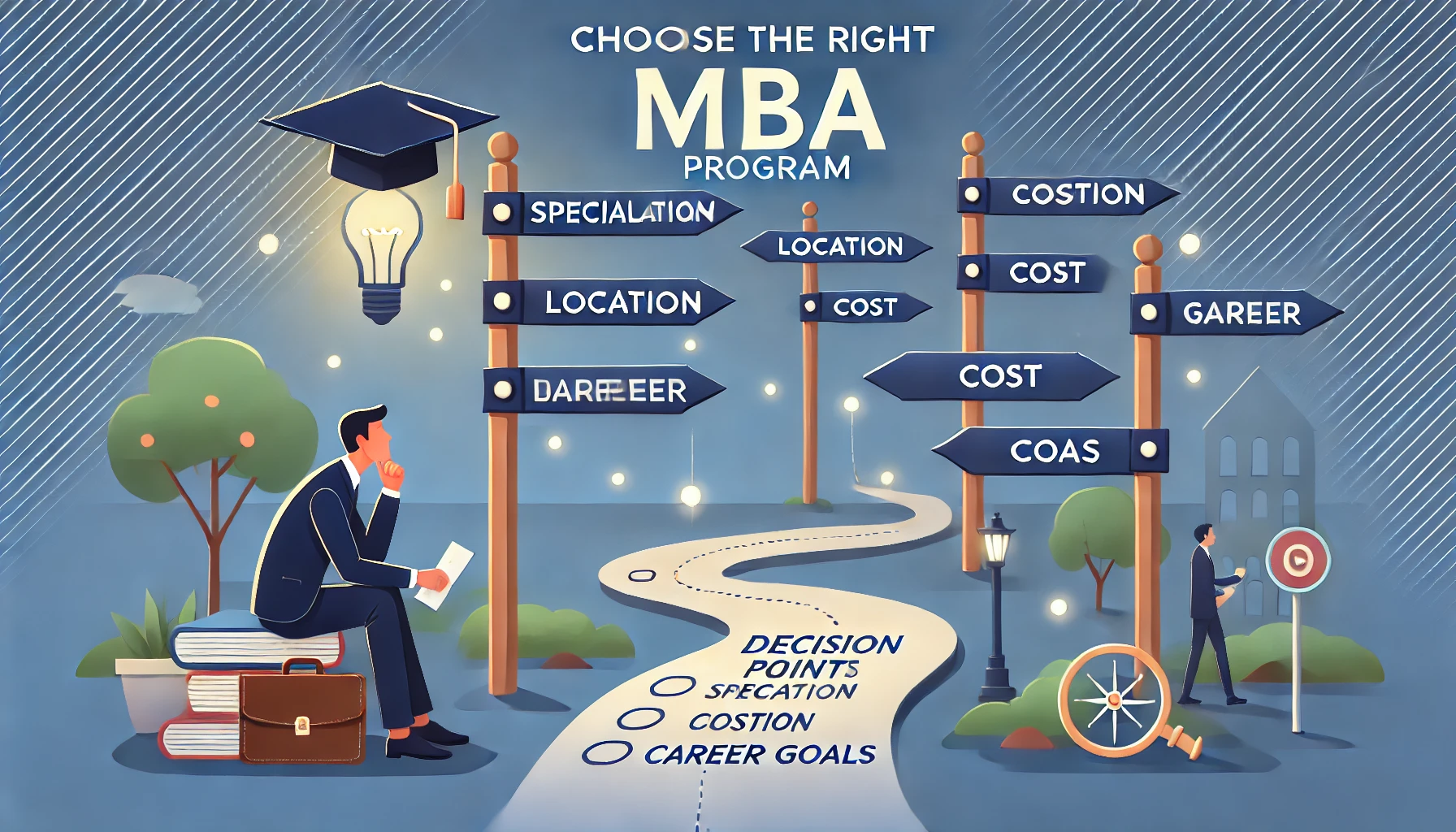Address
Fun Rush, [Erode], India
Work Hours
Monday to Friday: 7AM - 7PM


With thousands of MBA programs worldwide, choosing the right one can feel overwhelming. Should you go for a top-ranked school or focus on affordability? Should you choose a general MBA or a specialized one? This step-by-step guide will help you narrow down your options and find the MBA program that best fits your career goals, budget, and learning style.
Step 1: Define Your Career Goals 🎯 Before choosing an MBA, ask yourself:
🔹 Why do I want an MBA?
Career switch (e.g., from engineering to finance)
Career acceleration (promotion to leadership roles)
Entrepreneurship (starting your own business)
🔹 Which industry do I want to work in?
Finance, consulting, technology, healthcare, entrepreneurship?
🔹 Do I need a full-time, part-time, or online MBA?
Full-time MBA → Best for career switchers
Part-time MBA → Best for working professionals
Online MBA → Best for flexibility
💡 Pro Tip: Be clear about your end goal so you can choose a program that aligns with it.
Step 2: Decide Between a General vs. Specialized MBA 🔹 General MBA (Best for career switchers or broad leadership roles)
✔ Covers all business areas: finance, marketing, operations, strategy
✔ Provides flexibility to explore different industries
🔹 Specialized MBA (Best for those with a clear career path)
✔ MBA in Finance – For investment banking or corporate finance
✔ MBA in Marketing – For brand management and digital marketing
✔ MBA in Business Analytics – For data-driven decision-making and AI applications
✔ MBA in Human Resources – For HR leadership and talent management
✔ MBA in Operations Management – For supply chain and logistics expertise
💡 Pro Tip: If you know exactly what field you want, a specialized MBA can give you an edge.
Step 3: Research Business School Rankings and Reputation 🏆 Not all MBAs are equal. Here’s how to evaluate them:
Top MBA Rankings to Consider
📌 Financial Times Global MBA Rankings – Best for international MBAs
📌 QS World MBA Rankings – Focuses on employer reputation
📌 U.S. News & World Report – Best for U.S.-based MBAs
Key Factors to Compare
✔ Employment Rate – What percentage of graduates get jobs within 3-6 months?
✔ Average Salary Increase – Does the MBA significantly boost earning potential?
✔ Alumni Network Strength – Are graduates well-placed in top companies?
💡 Pro Tip: Rankings are important, but focus on how well a program matches your career goals.
Step 4: Check Admission Requirements 📝 Each MBA program has different admission criteria. Here’s what to expect:
🔹 GMAT/GRE Scores
Top MBAs (Harvard, Stanford, Wharton): GMAT 720+
Mid-tier MBAs (Michigan Ross, UCLA, Duke): GMAT 650-700
Some programs waive GMAT/GRE for experienced professionals
🔹 Work Experience
✔ Most top MBAs prefer 3-5 years of experience
✔ Executive MBAs require 8+ years of leadership experience
🔹 Essays & Interviews
✔ Schools look for strong leadership experience and career vision
✔ Personal statements and recommendations are crucial
💡 Pro Tip: Even with a lower GMAT score, a strong application with work experience, leadership, and networking can help you get in.
Step 5: Compare ROI and Cost 💰 An MBA is an investment, so it’s important to calculate Return on Investment (ROI).
MBA Costs (Tuition + Living Expenses)
📌 Top MBA Programs (Harvard, Stanford, Wharton): $150K – $200K
📌 Mid-Tier MBAs (UT Austin, Indiana Kelley, UNC): $80K – $120K
📌 Affordable MBAs (Online & Public Schools): $30K – $60K
How to Maximize ROI
✔ Choose an MBA with strong post-graduation salaries
✔ Look for scholarships and employer sponsorships
✔ Consider programs with high job placement rates
💡 Pro Tip: Don’t pick an expensive MBA unless the salary boost justifies the cost!
Step 6: Assess Alumni Network and Career Support 👥 A strong alumni network and career services can make a huge difference in landing top jobs.
🔹 Check Alumni Placements
✔ Where do graduates work? (Google, McKinsey, Goldman Sachs?)
✔ Do they hold leadership positions?
🔹 Career Services to Look For
✔ On-campus recruitment (Do top companies hire from this MBA?)
✔ Internship opportunities (Does the MBA help students get hands-on experience?)
✔ Mentorship programs (Are alumni actively involved in mentoring?)
💡 Pro Tip: A strong alumni network can open doors long after graduation.
Step 7: Choose the Best MBA for You ✅ Once you’ve researched everything, make your final decision based on these questions: ✔ Does the MBA align with my career goals?
✔ Does it have strong job placement rates in my industry?
✔ Can I afford the tuition without excessive debt?
✔ Does the program format fit my lifestyle? (Full-time vs. Part-time vs. Online)
💡 Final Thought: Don’t just choose an MBA for the brand—pick one that will help you reach your career goals efficiently.
Conclusion: Your MBA, Your Future Choosing an MBA is a major decision, but with careful research and goal setting, you can find the right fit for your career.
📍 Next Steps:
✅ Shortlist 5-10 MBA programs
✅ Check their admission deadlines
✅ Start working on your essays, GMAT, and recommendations
💬 Need help deciding on an MBA? Drop your questions below! ⬇️